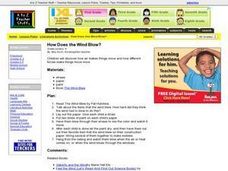Curated OER
Temperature Variations and Habitability
Pupils, in groups, evaluate conditions outside the building and inside the classroom using thermometers, barometers, anemometers, etc. They compare interior and exterior conditions. They consider and discuss factors that contribute to...
Curated OER
How Does the Wind Blow?
Students discover how the air makes objects move. They use a straw and paper with paint on it to test how hard they need to blow to make the paper move. They create mobiles and watch how they move when a window is open. They discuss what...
Curated OER
Let's Think About Air
Students explore the concept that air is all around us and identify ways that we can use air, and what air can do. They watch a short video that illustrates some of their findings.
Curated OER
Learning Lesson: How it is Currently Done
Students create their own ocean currents by using everyday items. They examine the constant pushing of molecules that makes us feel wind. They discuss how the water moves in the Southern Hemisphere.
Curated OER
Updrafts in Action
Students examine how wind can suspend rain and hail in clouds. They focus on safety precautions they can take to protect them from the hazards of thunderstorms.
Curated OER
Physical Characteristics of the Troposphere
Students examine troposphere graphs and mcompare their hypotheses with data collected by weather balloons launched from the NOAA ship, Ronald H. Brown. they write summaries about the physical properties of the troposphere.
Curated OER
Measuring Wind Speed
Fourth graders measure wind speed over a week's time uisng a ping pong and a protractor and graph the results. They convert the number of degrees to miles per hour using a scale. They discuss patterns and relationships.
Curated OER
Charting the Great Winds
Students examine winds and discover that, in ancient Greek cultures, they were named based on the direction from which they came. They, in groups, make a wind chart naming the winds and marking them on the chart.
Curated OER
Careers and Weather
Learners explore how weather affects a variety of jobs. Through a series of activity sheets, they determine what occupations create more or less activity because of weather conditions.
Curated OER
Transport
Students analyze wind barbs and determine which way the wind is blowing and how hard the wind is blowing. They access near real time wind data and pollutant animations to track the transport and destination of pollutants.
Concord Consortium
Concord Consortium: Stem Resources: Wind Generator
Using a voltage sensor, students will measure how much "electricity" is produced by the wind turbine that they design and build. Students will experiment with blade designs to see which one collects energy from the wind the most...
John F. Kennedy Center
The Kennedy Center: Lesson: Weather and Wind
Here's an engaging activity to incorporate dance into your science lessons on weather! Students study wind, and various weather patterns, then create their own dance to illustrate what they have learned. Provides links to more...
University of Regina (Canada)
University of Regina: Eolian Processes and Landforms
A detailed outline containing a large amount of material on wind erosion, describing wind transport mechanisms, and wind landform formation.
University of Illinois
University of Illinois Urbana Champaign: Forces and Winds
What causes wind? How does wind affect our weather? This website is neatly organized into topics about pressure, gradient force, Coriolis force, geostrophic wind, gradient wind, friction, boundary layer wind, and sea and land breezes....
Science Buddies
Science Buddies: Why Do Birds Fly in a v Formation?
In this science fair project, the student will make a wind tunnel to test how the formation of birds in flight affects flight efficiency. Make the bird models out of Legos and have fun with this project. The Science Buddies project ideas...
Science Buddies
Science Buddies: Winglets in Wind Tunnels
Have you noticed the little wing projections on the wings of jets? This Science Buddies project helps you understand whether these fins help stabilize airplanes. The Science Buddies project ideas are set up consistently beginning with an...
Science Buddies
Science Buddies: How Does a Wind Meter Work?
On a windy day it is hard to keep your hat on. The power of the wind can even be strong enough to power large wind turbines to make electricity. In this experiment, find out how you can make your own instrument to measure the speed and...
TryEngineering
Try Engineering: Measuring the Wind
Young scholars explore the design of anemometers and how they are used in measuring the speed of wind. Working in teams of "engineers", they will design, build, and evaluate the effectiveness of their own anemometers, presenting their...
PBS
Pbs Teachers:dragonfly Tv Cup
Apply knowledge of motion, forces and lift while sailing a boat around a race course.
Other
University of Windsor: Climates on a Rotating Earth
This site offers the text of a college lecture on the atmosphere, with information on the effect prevailing westerlies have on North America.
Other
Lehigh University: Energy
An inquiry-based science unit for middle school students centered on the world's energy sources. The lessons integrate technology and lab activities while teaching about energy sources, production, and consumption.
Other
American Red Cross: Masters of Disaster: Grades 6 8
This resource presents many science lessons with related activities for students in grades 6-8. Content addresses tools for coping with disasters such as tornadoes, fires, lightning, floods and general preparedness.
US Geological Survey
Usgs: Eolian Processes
A site containing a description of basic Eolian (wind) processes and how they effect various types of terrain. Includes many pictures which illustrate the presented concepts.
TeachEngineering
Teach Engineering: Let's Get Breezy!
Students apply an understanding of the concept of heat transfer through convection, conduction, and radiation as they use wireless temperature probes to investigate the heating capacity of different materials under heat lamps.






















